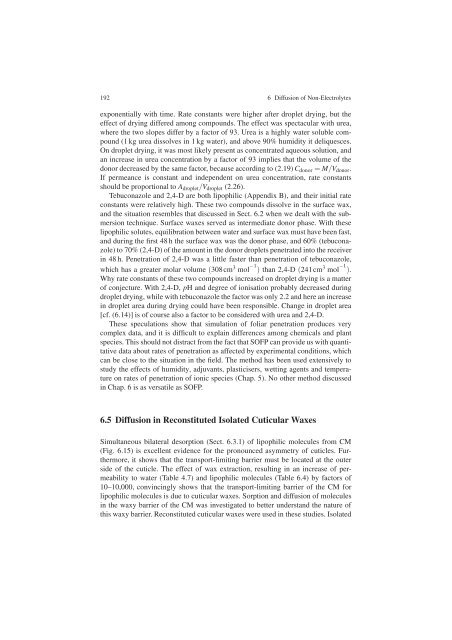Water and Solute Permeability of Plant Cuticles: Measurement and ...
Water and Solute Permeability of Plant Cuticles: Measurement and ...
Water and Solute Permeability of Plant Cuticles: Measurement and ...
You also want an ePaper? Increase the reach of your titles
YUMPU automatically turns print PDFs into web optimized ePapers that Google loves.
192 6 Diffusion <strong>of</strong> Non-Electrolytes<br />
exponentially with time. Rate constants were higher after droplet drying, but the<br />
effect <strong>of</strong> drying differed among compounds. The effect was spectacular with urea,<br />
where the two slopes differ by a factor <strong>of</strong> 93. Urea is a highly water soluble compound<br />
(1 kg urea dissolves in 1 kg water), <strong>and</strong> above 90% humidity it deliquesces.<br />
On droplet drying, it was most likely present as concentrated aqueous solution, <strong>and</strong><br />
an increase in urea concentration by a factor <strong>of</strong> 93 implies that the volume <strong>of</strong> the<br />
donor decreased by the same factor, because according to (2.19) Cdonor = M/Vdonor.<br />
If permeance is constant <strong>and</strong> independent on urea concentration, rate constants<br />
should be proportional to Adroplet/Vdroplet (2.26).<br />
Tebuconazole <strong>and</strong> 2,4-D are both lipophilic (Appendix B), <strong>and</strong> their initial rate<br />
constants were relatively high. These two compounds dissolve in the surface wax,<br />
<strong>and</strong> the situation resembles that discussed in Sect. 6.2 when we dealt with the submersion<br />
technique. Surface waxes served as intermediate donor phase. With these<br />
lipophilic solutes, equilibration between water <strong>and</strong> surface wax must have been fast,<br />
<strong>and</strong> during the first 48 h the surface wax was the donor phase, <strong>and</strong> 60% (tebuconazole)<br />
to 70% (2,4-D) <strong>of</strong> the amount in the donor droplets penetrated into the receiver<br />
in 48 h. Penetration <strong>of</strong> 2,4-D was a little faster than penetration <strong>of</strong> tebuconazole,<br />
which has a greater molar volume (308cm 3 mol −1 ) than 2,4-D (241cm 3 mol −1 ).<br />
Why rate constants <strong>of</strong> these two compounds increased on droplet drying is a matter<br />
<strong>of</strong> conjecture. With 2,4-D, pH <strong>and</strong> degree <strong>of</strong> ionisation probably decreased during<br />
droplet drying, while with tebuconazole the factor was only 2.2 <strong>and</strong> here an increase<br />
in droplet area during drying could have been responsible. Change in droplet area<br />
[cf. (6.14)] is <strong>of</strong> course also a factor to be considered with urea <strong>and</strong> 2,4-D.<br />
These speculations show that simulation <strong>of</strong> foliar penetration produces very<br />
complex data, <strong>and</strong> it is difficult to explain differences among chemicals <strong>and</strong> plant<br />
species. This should not distract from the fact that SOFP can provide us with quantitative<br />
data about rates <strong>of</strong> penetration as affected by experimental conditions, which<br />
can be close to the situation in the field. The method has been used extensively to<br />
study the effects <strong>of</strong> humidity, adjuvants, plasticisers, wetting agents <strong>and</strong> temperature<br />
on rates <strong>of</strong> penetration <strong>of</strong> ionic species (Chap. 5). No other method discussed<br />
in Chap. 6 is as versatile as SOFP.<br />
6.5 Diffusion in Reconstituted Isolated Cuticular Waxes<br />
Simultaneous bilateral desorption (Sect. 6.3.1) <strong>of</strong> lipophilic molecules from CM<br />
(Fig. 6.15) is excellent evidence for the pronounced asymmetry <strong>of</strong> cuticles. Furthermore,<br />
it shows that the transport-limiting barrier must be located at the outer<br />
side <strong>of</strong> the cuticle. The effect <strong>of</strong> wax extraction, resulting in an increase <strong>of</strong> permeability<br />
to water (Table 4.7) <strong>and</strong> lipophilic molecules (Table 6.4) by factors <strong>of</strong><br />
10–10,000, convincingly shows that the transport-limiting barrier <strong>of</strong> the CM for<br />
lipophilic molecules is due to cuticular waxes. Sorption <strong>and</strong> diffusion <strong>of</strong> molecules<br />
in the waxy barrier <strong>of</strong> the CM was investigated to better underst<strong>and</strong> the nature <strong>of</strong><br />
this waxy barrier. Reconstituted cuticular waxes were used in these studies. Isolated







